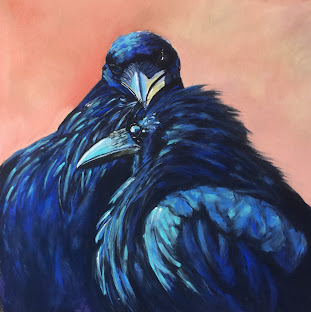"Newcomer"
Pastel 18 x 24 inches
Chickadees are the busybodies of the forest, peering into crevices, exploring tangles, studying twigs and pine cones, and constantly chattering about it. When they aren't nesting, chickadees are quite social, and travel in small groups of up to ten birds. Other songbirds understand the chickadee's calls and often join their roving groups. By relying on the chickadees to watch for danger, the other birds have more time to focus on foraging. This can be particularly helpful to migrants. A migrating warbler that has just landed in an unfamiliar woodland at dawn can take advantage of the experience of the local chickadees. Following them as they move through the forest will be relatively safe, and will lead to the best sources of food and water.
Despite the fact that chickadees are reliable and consistent visitors to bird feeders (they especially like sunflower seeds), more than half of their diet year-round is animal prey. In the northern winter, they hunt for dormant tiny insects and spiders, including eggs and larvae, which are found in bark crevices and dead leaf clusters, along twigs, and in other such places. In the summer, they mostly bring small caterpillars to their nestlings (they can collect over a thousand in a day), but for the first week or so after hatching the adults make special efforts to seek out spiders to feed to their young. Spiders provide the nutrient taurine, which is essential for brain development and other functions.
From: What It's Like To Be A Bird by David Allen Sibley
Each morning I have the pleasure of sipping my morning coffee in front of our large living room window which looks out to our many bird feeders under our front yard oak tree. With binoculars at the ready, I can delight in the resident chickadees, finches, and titmice while be occasionally surprised by the seasonal visitor like the grosbeak or warbler.
Birdwatching became an activity that my husband and I now share after our first date when he packed up a lunch and some binoculars and took me to a local lake in San Diego county and introduced me to the world of birds. What a "nerdy" first date, I thought to myself! As a native to the city of Los Angeles, the only birds I ever knew were represented in horror films like Alfred Hitchcock's "The Birds"!
This newfound love affair with my now husband has led to a 3 decade long love affair with our winged friends of the sky! Coming full circle after a career as an ICU registered nurse for 10 years then a full time mom to my two amazing young adult kids, I now find passionate joy in the recreation of my feathered kindred spirits in my art. It is with great joy that I share this passion with you!
Don't forget to look up at the sky and be grateful for the birds.....







